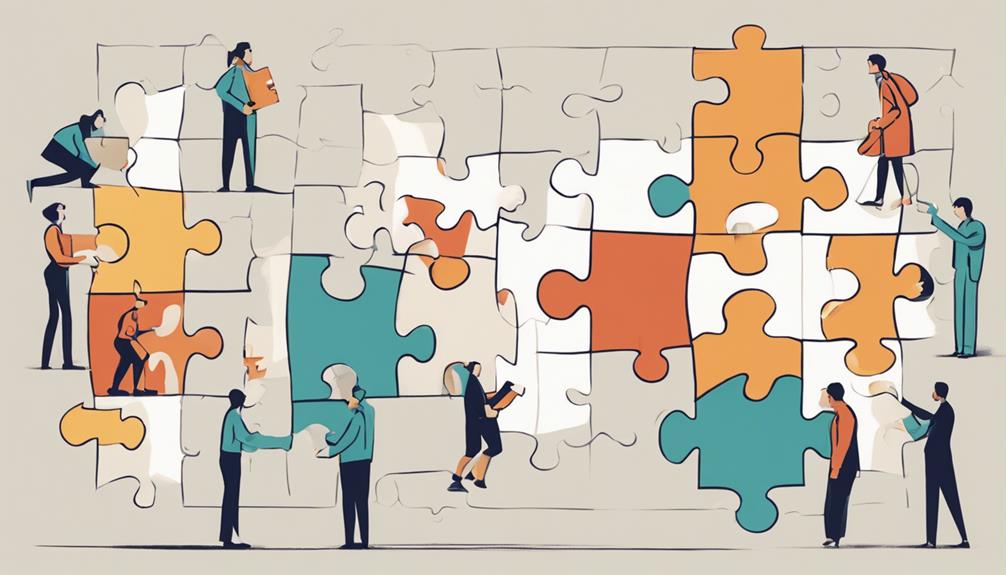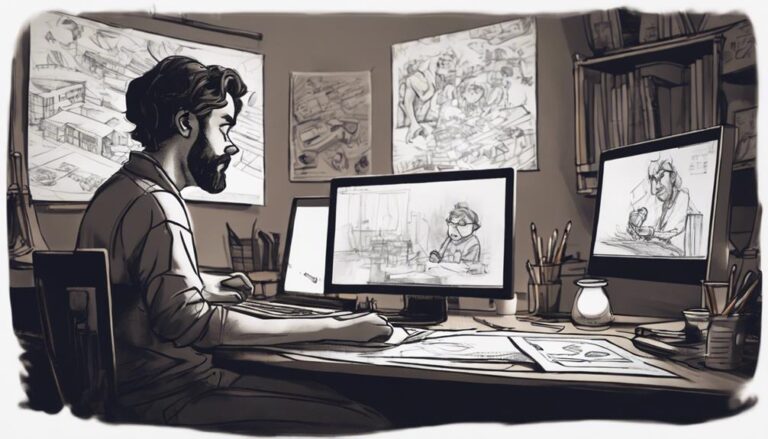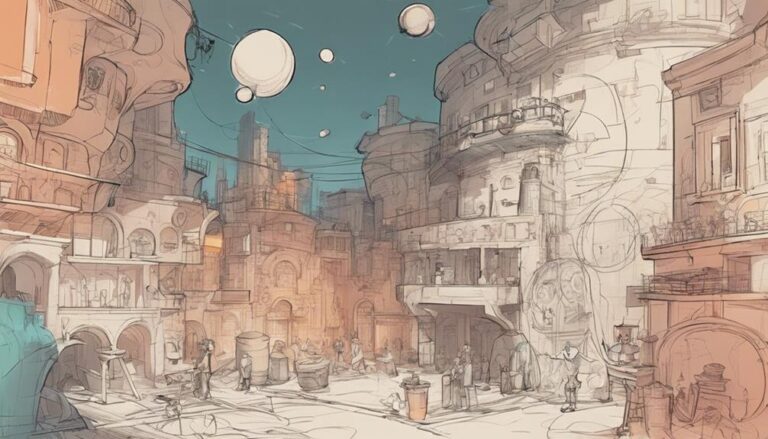Why Visual Development Process Works
By implementing a visual development process, you'll experience a seismic shift in your workflow. Team collaboration and communication will improve, as clear expectations and roles eliminate confusion and overlapping work. Productivity will soar, with streamlined processes and task delegation reducing burnout and increasing high-quality results. Effective problem-solving and issue identification will become the norm, and project planning will be enhanced through visual learning. As you harness the power of visual development, you'll reduce miscommunication risks and boost project quality – and discover even more benefits that'll take your workflow to the next level.
Key Takeaways
- Visual development processes enhance team collaboration and communication, ensuring everyone works towards a common goal.
- Effective project planning guides the entire visual development process, defining objectives, scope, and deliverables.
- Visual learning improves brain function, stimulates creativity, and reduces cognitive overload, leading to better problem-solving skills.
- Streamlined processes and clear expectations enable team members to work efficiently and focus on high-priority tasks.
- Visual development reduces miscommunication risks and enhances project quality by establishing clear expectations and consistency from the outset.
Improved Team Collaboration
Effective visual development teams don't just happen; they're built on a foundation of seamless collaboration.
To achieve this, you need to establish a clear understanding of design roles within your team. This involves defining each member's responsibilities, expertise, and areas of focus. By doing so, you'll prevent confusion and overlapping work, ensuring that each team member is working towards a common goal.
When it comes to team dynamics, you should strive for a culture that encourages open feedback, transparency, and trust.
This allows team members to share their ideas, concerns, and expertise freely, leading to more effective problem-solving and decision-making. By fostering a collaborative environment, you'll be able to leverage the diverse skills and perspectives of your team to create innovative visual solutions.
To further improve team collaboration, consider implementing regular team meetings, progress updates, and feedback sessions.
This will keep everyone on the same page, ensure that all voices are heard, and provide opportunities for growth and improvement. By investing in your team's collaboration, you'll reap the benefits of increased productivity, creativity, and overall success.
Enhanced Communication Methods
By building on the foundation of seamless collaboration within your visual development team, you're poised to unlock the full potential of your team's diverse skills and expertise. This is achieved by implementing enhanced communication methods that foster a culture of transparency, clarity, and creativity. Two key strategies for achieving this are Digital Storyboarding and Visual Roadmapping.
| Method | Description |
|---|---|
| Digital Storyboarding | A visual representation of your project's narrative, allowing team members to see the sequence of events and how their work fits into the bigger picture. |
| Visual Roadmapping | A dynamic, high-level visualization of your project's milestones, goals, and timelines, enabling the team to stay focused on the project's overall direction. |
| Feedback Loops | Regular check-ins and feedback sessions to ensure that all team members are on the same page and that any issues are addressed promptly. |
| Progress Tracking | Using visual aids to track progress, identify roadblocks, and make data-driven decisions to drive the project forward. |
Increased Productivity Levels
With a well-oiled visual development team in place, and enhanced communication methods driving collaboration, you're likely to see a significant boost in productivity levels.
This uptick in productivity is largely due to the fact that team members are now able to work more efficiently, thanks to streamlined processes and clear expectations. Effective time management becomes second nature when everyone is on the same page, and tasks are delegated in a way that maximizes each team member's strengths.
As a result, you'll notice that projects are completed faster, and with fewer roadblocks.
Team members are able to focus on high-priority tasks, and delegate secondary tasks to others who can handle them. This not only increases productivity but also reduces the risk of burnout.
With clear communication and task delegation, team members can work together seamlessly, producing high-quality results in a shorter amount of time.
Effective Problem Solving
When tackling complex problems in your visual development process, you'll need to pinpoint and prioritize key issues that hinder progress.
By doing so, you'll be able to allocate resources more efficiently and focus on the most critical challenges.
Effective problem-solving begins with a thorough analysis of root causes, enabling you to develop targeted solutions that address the underlying issues.
Prioritizing Key Issues
At the top of your problem-solving list, six to eight key issues typically vie for your attention, each clamoring to be addressed first. To prioritize these issues effectively, consider the impact of each on your project's overall success. Start by evaluating each issue's level of complexity, potential risk, and alignment with stakeholder input.
| Issue | Design Constraints | Impact Level |
|---|---|---|
| Technical Debt | High | Critical |
| Resource Constraints | Medium | High |
| User Experience | Low | Medium |
| Project Timeline | High | Critical |
| Budget Allocation | Medium | High |
When evaluating these issues, consider the design constraints that may limit your ability to address them. For example, technical debt may require significant resources to resolve, while user experience issues may be addressed through iterative design changes. By prioritizing issues based on their impact level and alignment with stakeholder input, you can focus on the most critical problems first and allocate resources effectively. This strategic approach ensures that you're addressing the most pressing issues and setting your project up for success.
Analyzing Root Causes
To tackle complex problems, you need to go beyond surface-level symptoms and dig deeper to identify the root causes that are driving these issues.
This is where effective problem-solving techniques come into play. Analyzing root causes is a critical step in the visual development process, and it involves using tools like cause mapping to uncover the underlying factors contributing to a problem.
Cause mapping is a visual technique that helps you identify, organize, and analyze the possible causes of a problem.
By creating a map of the different causes and their relationships, you can see the bigger picture and understand how different factors interact with each other.
Failure analysis is another technique that can be used to identify root causes.
This involves examining the sequence of events leading up to a failure or problem, and identifying the key factors that contributed to it.
Better Issue Identification
As you refine your problem-solving skills, you'll want to focus on identifying issues earlier and more accurately.
This involves developing a keen eye for early problem detection, clearly defining the issue at hand, and applying a rigorous root cause analysis to uncover the underlying sources of the problem.
Early Problem Detection
Early on in the visual development process, you'll often uncover issues that could derail your project if left unchecked.
This is especially true when it comes to design flaws, which can significantly impact your project's overall quality and success. By detecting these issues early, you can avoid the ripple effect of defects that can spread throughout your project, ultimately increasing defect density.
Identifying problems early allows you to address them before they become ingrained in your project.
This proactive approach enables you to refine your design, making the necessary adjustments to prevent costly rework and ensuring that your project stays on track. By doing so, you can reduce the number of defects and improve the overall quality of your project.
Visual development process empowers you to identify potential issues early, giving you the opportunity to rectify them before they become major problems.
This enables you to deliver a high-quality project that meets the required standards, while also reducing the time and resources spent on rework. By detecting issues early, you can ensure that your project is completed efficiently, effectively, and to a high standard.
Clear Issue Definition
When design flaws are detected early in the visual development process, they can be addressed and refined, but the key to effective issue resolution lies in clear issue definition.
You must be able to identify the problem, its root cause, and its impact on your project. This is where clear issue definition comes in – it's the process of distilling the problem down to its essence, making it easier to understand and address.
Clear issue definition is crucial in ensuring that you're tackling the right problem. It involves setting clear goals for what you want to achieve and defining the issue with precision.
By doing so, you'll be able to focus on the key aspects of the problem, eliminating unnecessary complexity and distractions. Issue clarity is essential in this process, as it enables you to develop targeted solutions that address the problem's underlying causes.
With clear issue definition, you'll be able to create a roadmap for resolution, outlining the specific steps needed to address the problem.
This will help you allocate resources more effectively, prioritize tasks, and make informed decisions that drive your project forward.
Root Cause Analysis
Most visual development issues have a multitude of symptoms, but only a handful of root causes.
When you're faced with a complex problem, it's essential to dig deeper to identify the underlying causes. Root cause analysis (RCA) is a systematic approach to identifying the primary cause of a problem.
By using RCA, you'll be able to pinpoint the root cause of the issue, rather than just treating its symptoms.
To perform an effective RCA, start by gathering data and information about the issue.
Then, use cause mapping to visually represent the relationships between different factors.
This will help you identify potential failure modes and narrow down the possible causes.
Ask yourself questions like "What happened?" "Why did it happen?" and "What were the consequences?"
Enhanced Project Planning
Effective project planning is your roadmap to success, guiding the entire visual development process.
You must clearly define your project's objectives, scope, and deliverables to ensure everyone involved is on the same page.
A well-planned project timeline is crucial in setting realistic milestones and deadlines. By breaking down the project into manageable tasks, you can allocate resources more efficiently and avoid last-minute rushes.
When it comes to resource allocation, you need to identify the skills and expertise required for each task.
This involves assigning the right people to the right tasks, as well as allocating sufficient time and budget. A well-thought-out resource allocation plan helps prevent bottlenecks and ensures that your project stays on track.
By considering potential roadblocks and developing contingency plans, you can mitigate risks and minimize delays.
A solid project plan also enables you to track progress, identify areas for improvement, and make data-driven decisions.
Visual Learning Advantages
By integrating your well-planned project timeline with the power of visual learning, you're poised to accelerate the development process.
Visual aids play a crucial role in enhancing your team's understanding of complex concepts and project requirements.
By leveraging visual aids, you're able to tap into the brain's preference for processing visual information, which can lead to faster comprehension and retention.
Research has shown that visual learning can improve brain function by increasing the activity in areas responsible for attention, perception, and memory.
When you use visual aids, you're able to stimulate both hemispheres of the brain, which can lead to better problem-solving skills and enhanced creativity.
Moreover, visual learning can help reduce cognitive overload, allowing your team to focus on high-level thinking and decision-making.
Reduced Miscommunication Risks
Tapping into the potential of visual learning, you're also able to significantly reduce the risks of miscommunication within your team.
By incorporating visual elements into your development process, you can ensure that all team members are on the same page, with a clear understanding of the project's goals and objectives. This clarity is crucial in preventing miscommunication, as it eliminates the need for verbal explanations that can be easily misinterpreted.
Visual development processes allow you to establish clear expectations from the outset.
By defining project requirements and objectives through visual aids, you can create a shared understanding among team members, reducing the risk of miscommunication and errors.
Consistent language is also a key benefit of visual development processes. By using standardized visual elements and terminology, you can ensure that all team members are speaking the same language, reducing the risk of misunderstandings and miscommunication.
This streamlined communication enables teams to work more efficiently and effectively, delivering high-quality results.
Streamlined Workflow Processes
Streamlining your workflow processes is essential to achieving project success.
By implementing efficient and effective processes, you'll be able to minimize delays, reduce costs, and maximize productivity.
In the context of visual development, streamlining workflow processes is critical to ensuring that design and development teams work seamlessly together.
You can achieve streamlined workflow processes by incorporating Design Sprints and Agile Frameworks into your visual development process.
Design Sprints allow you to rapidly prototype and test solutions, while Agile Frameworks enable you to break down complex projects into manageable, iterative chunks.
Frequently Asked Questions
What Tools Are Required for a Successful Visual Development Process?
You'll need design software like Adobe Creative Cloud, Sketch, or Figma to bring your ideas to life. Additionally, collaboration platforms like Slack, Trello, or Asana will keep your team aligned and working efficiently towards your goals.
Can Visual Development Be Applied to All Industries and Projects?
You can apply visual development to most industries and projects, but it's not universally applicable. Industry limitations and specific project requirements can restrict its effectiveness, requiring tailored approaches to maximize its benefits and strategic value.
How Does Visual Development Benefit Remote or Distributed Teams?
When working with remote teams, you'll find that virtual whiteboards and remote collaboration tools amplify visual development's impact. You can now share and iterate on visual ideas in real-time, enhancing communication and streamlining the development process.
Are Visual Development Processes Adaptable to Changing Project Requirements?
You'll find that adaptable visual development processes thrive when you maintain a flexible roadmap and cultivate an agile mindset, allowing you to pivot quickly in response to changing project requirements and priorities.
What Skills Are Necessary for a Team to Implement Visual Development Effectively?
To implement visual development effectively, you'll need a team with skills like design thinking, collaboration, and stakeholder buy-in. They must be able to distill complex ideas, prioritize needs, and communicate visually to drive project success.
Conclusion
By embracing the visual development process, you'll unlock a more collaborative, productive, and streamlined workflow. Visual tools will bridge communication gaps, enhance problem-solving, and give you a head start on issue identification. As a result, your project planning will become more effective, and your team will make better decisions. Ultimately, you'll reduce miscommunication risks and supercharge your workflow, leading to more successful projects and a competitive edge.







